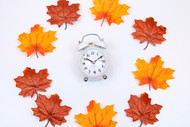Don’t Lose Sleep over Daylight Saving Time
What is Daylight Saving Time?
Daylight saving time gives many areas worldwide an extra hour of daylight in the evening. In the United States, daylight saving time goes from March to November. In the spring you set your clocks back one hour, effectively losing an hour of sleep—but you get that extra hour of sleep back in the fall.
Why Did it Start?
As it happens, Benjamin Franklin was a long-time supporter of waking up early and going to bed early at night—if only to extend the life of candles. There were also other well-known supporters, including President Wilson and President Roosevelt who signed daylight saving time into practice during World War I and World War II as a means to conserve energy. The practice stuck around for good after the Uniform Time Act in 1966. To this day, some states observe daylight saving time and some don’t, making it a somewhat complicated practice.
How Does it Impact Sleep?
Any time you change your daily routine, it can throw off your sleep schedule. A one-hour difference may not seem like a big change, but sleep experts say it can impact you more than you might think, noting upticks in heart problems, mood disorders, and even car accidents.
Ways to Make the Switch Easier
The daylight saving time switch can be a total pain—and not just because you have to update the time on your microwave. Follow these four tips to ease into the change.
Take a Daytime Nap
Looking for a legitimate reason to take a nap during the day? Daylight savings time is one more reason you should consider it. If you’ve been missing that extra hour of sleep or have thrown off your sleep schedule with the change, a nap is definitely in order. While your body adjusts to the new schedule, take a quick 15-minute power nap to help you feel more rested.
Become a Morning Person
If you’re always running late, consider this the universe’s way of helping you out. With the daylight saving time shift in the fall, you’ve now got an extra hour to clock into work, head to the gym, or have a leisurely breakfast. Thinking of starting a new morning routine? This is the perfect time to do it—keep your body used to waking up early so you have the perfect jumpstart to the day.
Go to Bed on Time
While it might be tempting to stay up later in the evenings because your body doesn’t get tired until later, you might end up regretting that decision in the morning. When the sun goes down earlier in the evening, take it as your que to start your nightly routine. Start winding down from the day and even go to bed early—your body will thank you later.
Get a Sunrise Alarm
Struggling with short days? You’re not alone. If you prefer waking up with the sun, look into an alarm that gradually grows brighter in the morning, helping you wake up more naturally. This can be a great way to get your body back on schedule even if the sunrise doesn’t match up to your sleep schedule. There are plenty of great options out there and even a few recommendations from the New York Times.
Getting Back on Schedule
We know how important sleep is, so we hope these tips help you get your sleep schedule back on track every spring and fall. Whether you’re having trouble sleeping because of daylight saving time or something else, we’re here to help you find better sleep any time of the day or night.
